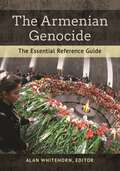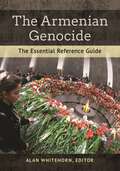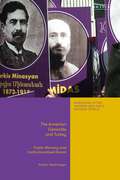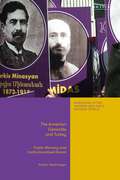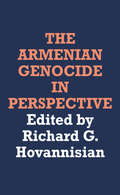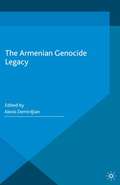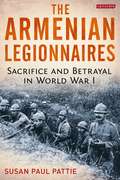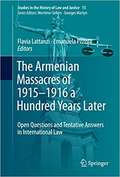- Table View
- List View
The Armenian Diaspora and Stateless Power: Collective Identity in the Transnational 20th Century (Armenians in the Modern and Early Modern World)
From genocide, forced displacement, and emigration, to the gradual establishment of sedentary and rooted global communities, how has the Armenian diaspora formed and maintained a sense of collective identity? This book explores the richness and magnitude of the Armenian experience through the 20th century to examine how Armenian diaspora elites and their institutions emerged in the post-genocide period and used “stateless power” to compose forms of social discipline. Historians, cultural theorists, literary critics, sociologists, political scientists, and anthropologists explore how national and transnational institutions were built in far-flung sites from Istanbul, Aleppo, Beirut and Jerusalem to Paris, Los Angeles, and the American mid-west. Exploring literary and cultural production as well as the role of religious institutions, the book probes the history and experience of the Armenian diaspora through the long 20th century, from the role of the fin-de-siècle émigré Armenian press to the experience of Syrian-Armenian asylum seekers in the 21st century. It shows that a diaspora's statelessness can not only be evidence of its power, but also how this “stateless power” acts as an alternative and complement to the nation-state.
The Armenian Experience: From Ancient Times to Independence
by Gaïdz MinassianArmenian national identity has long been associated with what has come to be known as the Armenian Genocide of 1915. Immersing the reader in the history, culture and politics of Armenia – from its foundations as the ancient kingdom of Urartu to the modern-day Republic – Gaïdz Minassian moves past the massacres embedded in the Armenian psyche to position the nation within contemporary global politics. An in-depth study of history and memory, The Armenian Experience examines the characteristics and sentiments of a national identity that spans the globe. Armenia lies in the heart of the Caucasus and once had an empire – under the rule of Tigranes the Great in the first century BC – that stretched from the Caspian to the Mediterranean seas. Beginning with an overview of Armenia's historic position at the crossroads between Rome and Persia, Minassian details invasions from antiquity to modern times by Arabs, Mongols, Ottomans, Persians and Russians right up to its Soviet experience, and drawing on Armenia's post-Soviet conflict with Azerbaijan in its attempts to reunify with the disputed territory of Nagorno-Karabakh. This book questions an Armenian self-identity dominated by its past and instead looks towards the future. Gaïdz Minassian emphasises the need to recognise that the Armenian story began well before the Genocide 1915, and continues as an on-going modern narrative.
The Armenian Experience: From Ancient Times to Independence
by Gaïdz MinassianArmenian national identity has long been associated with what has come to be known as the Armenian Genocide of 1915. Immersing the reader in the history, culture and politics of Armenia – from its foundations as the ancient kingdom of Urartu to the modern-day Republic – Gaïdz Minassian moves past the massacres embedded in the Armenian psyche to position the nation within contemporary global politics. An in-depth study of history and memory, The Armenian Experience examines the characteristics and sentiments of a national identity that spans the globe. Armenia lies in the heart of the Caucasus and once had an empire – under the rule of Tigranes the Great in the first century BC – that stretched from the Caspian to the Mediterranean seas. Beginning with an overview of Armenia's historic position at the crossroads between Rome and Persia, Minassian details invasions from antiquity to modern times by Arabs, Mongols, Ottomans, Persians and Russians right up to its Soviet experience, and drawing on Armenia's post-Soviet conflict with Azerbaijan in its attempts to reunify with the disputed territory of Nagorno-Karabakh. This book questions an Armenian self-identity dominated by its past and instead looks towards the future. Gaïdz Minassian emphasises the need to recognise that the Armenian story began well before the Genocide 1915, and continues as an on-going modern narrative.
The Armenian Genocide: Evidence from the German Foreign Office Archives, 1915-1916
by Wolfgang GustIn 1915, the Armenians were exiled from their land, and in the process of deportation 1.5 million of them were killed. The 1915-1916 annihilation of the Armenians was the archetype of modern genocide, in which a state adopts a specific scheme geared to the destruction of an identifiable group of its own citizens. Official German diplomatic documents are of great importance in understanding the genocide, as only Germany had the right to report day-by-day in secret code about the ongoing genocide. The motives, methods, and after-effects of the Armenian Genocide echoed strongly in subsequent cases of state-sponsored genocide. Studying the factors that went into the Armenian Genocide not only gives us an understanding of historical genocide, but also provides us with crucial information for the anticipation and possible prevention of future genocides.
The Armenian Genocide: Wartime Radicalization or Premeditated Continuum
by Richard G. HovannisianWorld War I was a watershed, a defining moment, in Armenian history. Its effects were unprecedented in that it resulted in what no other war, invasion, or occupation had achieved in three thousand years of identifiable Armenian existence. This calamity was the physical elimination of the Armenian people and most of the evidence of their ever having lived on the great Armenian Plateau, to which the perpetrator side soon gave the new name of Eastern Anatolia. The bearers of an impressive martial and cultural history, the Armenians had also known repeated trials and tribulations, waves of massacre, captivity, and exile, but even in the darkest of times there had always been enough remaining to revive, rebuild, and go forward.This third volume in a series edited by Richard Hovannisian, the dean of Armenian historians, provides a unique fusion of the history, philosophy, literature, art, music, and educational aspects of the Armenian experience. It further provides a rich storehouse of information on comparative dimensions of the Armenian genocide in relation to the Assyrian, Greek and Jewish situations, and beyond that, paradoxes in American and French policy responses to the Armenian genocides. The volume concludes with a trio of essays concerning fundamental questions of historiography and politics that either make possible or can inhibit reconciliation of ancient truths and righting ancient wrongs.
The Armenian Genocide: Wartime Radicalization or Premeditated Continuum
by Richard G. HovannisianWorld War I was a watershed, a defining moment, in Armenian history. Its effects were unprecedented in that it resulted in what no other war, invasion, or occupation had achieved in three thousand years of identifiable Armenian existence. This calamity was the physical elimination of the Armenian people and most of the evidence of their ever having lived on the great Armenian Plateau, to which the perpetrator side soon gave the new name of Eastern Anatolia. The bearers of an impressive martial and cultural history, the Armenians had also known repeated trials and tribulations, waves of massacre, captivity, and exile, but even in the darkest of times there had always been enough remaining to revive, rebuild, and go forward.This third volume in a series edited by Richard Hovannisian, the dean of Armenian historians, provides a unique fusion of the history, philosophy, literature, art, music, and educational aspects of the Armenian experience. It further provides a rich storehouse of information on comparative dimensions of the Armenian genocide in relation to the Assyrian, Greek and Jewish situations, and beyond that, paradoxes in American and French policy responses to the Armenian genocides. The volume concludes with a trio of essays concerning fundamental questions of historiography and politics that either make possible or can inhibit reconciliation of ancient truths and righting ancient wrongs.
The Armenian Genocide: A Complete History
by Raymond KévorkianThe Armenian Genocide was one of the greatest atrocities of the twentieth century, an episode in which up to 1.5 million Armenians lost their lives. In this major new history, the renowned historian Raymond Kevorkian provides an authoritative account of the origins, events and consequences of the years 1915 and 1916. He considers the role that the Armenian Genocide played in the construction of the Turkish nation state and Turkish identity, as well as exploring the ideologies of power, rule and state violence. Crucially, he examines the consequences of the violence against the Armenians, the implications of deportations and attempts to bring those who committed the atrocities to justice. Kevorkian offers a detailed and meticulous record, providing an authoritative analysis of the events and their impact upon the Armenian community itself, as well as the development of the Turkish state. This important book will serve as an indispensable resource to historians of the period, as well as those wishing to understand the history of genocidal violence more generally.
The Armenian Genocide: A Complete History
by Raymond KévorkianThe Armenian Genocide was one of the greatest atrocities of the twentieth century, an episode in which up to 1.5 million Armenians lost their lives. In this major new history, Raymond Kévorkian provides a long-awaited authoritative account of origins, events, and consequences of the years 1915 and 1916. Kévorkian explains and analyses the debates that occurred within the elite circles of the Young Turks, and traces the roots of the violence that would be raged upon the Ottoman Armenians. Uniquely, this is also a geographical account of the Armenian genocide, documenting its course region by region, including a complete account of the deportations, massacres and resistance that occurred.Kévorkian considers the role that the Armenian Genocide played in the construction of the Turkish nation state and Turkish identity, as well as exploring the ideologies of power, rule, and state violence, presenting an important contribution to the understanding of how such destruction could have occurred. Thus, Kévorkian examines the history of the Young Turks and the Armenians in the Ottoman Empire as they came into conflict with one another, taking into consideration the institutional, political, social and even psychological mechanisms that culminated in the destruction of the Ottoman Armenians. Beginning with an exploration of the origins of the Young Turk Revolution in 1908, Kévorkian analyses the decision making process which led to the terrible fate of those who were deported to the concentration camps of Aleppo and along the Euphrates.Crucially, 'The Armenian Genocide' also examines the consequences of the violence against the Armenians, the implications of the expropriation of property and assets, and deportations, as well as the attempts to bring those who committed atrocities to justice. This covers the documents from the Mazhar Governmental Commission of Inquiry and the formation of courts martial by the Ottoman authorities, and the findings of the March 1920 Committee for the Protection of the Minorities in Turkey, created by the League of Nations.Kévorkian offers a detailed and meticulous account of the Armenian Genocide, providing an authoritative analysis of the events and their impact upon the Armenian community itself, as well as the development of the Turkish state. This important book will serve as an indispensable resource to historians of the period, as well as those wishing to understand the history of genocidal violence more generally.
The Armenian Genocide: The Essential Reference Guide
by Alan WhitehornWith its analytical introductory essays, more than 140 individual entries, a historical timeline, and primary documents, this book provides an essential reference volume on the Armenian Genocide.The Armenian Genocide has often been considered a template for subsequent genocides and is one of the first genocides of the 20th century. As such, it holds crucial historical significance, and it is critically important that today's students understand this case study of inhumanity. This book provides a much-needed, long-overdue reference volume on the Armenian Genocide. It begins with seven introductory analytical essays that provide a broad overview of the Armenian Genocide and then presents individual entries, a historical timeline, and a selection of documents.This essential reference work covers all aspects of the Armenian Genocide, including the causes, phases, and consequences. It explores political and historical perspectives as well as the cultural aspects. The carefully selected collection of perspective essays will inspire critical thinking and provide readers with insight into some of the most controversial and significant issues of the Armenian Genocide. Similarly, the primary source documents are prefaced by thoughtful introductions that will provide the necessary context to help students understand the significance of the material.
The Armenian Genocide: The Essential Reference Guide
by Alan WhitehornWith its analytical introductory essays, more than 140 individual entries, a historical timeline, and primary documents, this book provides an essential reference volume on the Armenian Genocide.The Armenian Genocide has often been considered a template for subsequent genocides and is one of the first genocides of the 20th century. As such, it holds crucial historical significance, and it is critically important that today's students understand this case study of inhumanity. This book provides a much-needed, long-overdue reference volume on the Armenian Genocide. It begins with seven introductory analytical essays that provide a broad overview of the Armenian Genocide and then presents individual entries, a historical timeline, and a selection of documents.This essential reference work covers all aspects of the Armenian Genocide, including the causes, phases, and consequences. It explores political and historical perspectives as well as the cultural aspects. The carefully selected collection of perspective essays will inspire critical thinking and provide readers with insight into some of the most controversial and significant issues of the Armenian Genocide. Similarly, the primary source documents are prefaced by thoughtful introductions that will provide the necessary context to help students understand the significance of the material.
The Armenian Genocide and Turkey: Public Memory and Institutionalized Denial (Armenians in the Modern and Early Modern World)
by Hakan SeckinelginHow is official denial of the Armenian genocide maintained in Turkey? In this book, Hakan Seckinelgin investigates the mechanisms by which denial of the events of 1915 are reproduced in official discourse, and the effect this has on Turkish citizens. Examining state education, media discourse, academic publications, as well as public events debating the Armenian genocide, the book argues that, at the public level, there exists a 'grammar' or 'repertoire' of denial in Turkey which regulates how the issue can be publicly conceptualised and understood. The book's careful analysis examines the way that knowledge about the genocide is censored in Turkey, from the language that must be used to publicly discuss it, to the complex way in which selective knowledge and erased history is reproduced, from 1915 and subsequent generations until today. It argues that denialism has become important to a certain kind Turkish national identity and belonging – and suggests ways in which this relationship can be unpicked in future.
The Armenian Genocide and Turkey: Public Memory and Institutionalized Denial (Armenians in the Modern and Early Modern World)
by Hakan SeckinelginHow is official denial of the Armenian genocide maintained in Turkey? In this book, Hakan Seckinelgin investigates the mechanisms by which denial of the events of 1915 are reproduced in official discourse, and the effect this has on Turkish citizens. Examining state education, media discourse, academic publications, as well as public events debating the Armenian genocide, the book argues that, at the public level, there exists a 'grammar' or 'repertoire' of denial in Turkey which regulates how the issue can be publicly conceptualised and understood. The book's careful analysis examines the way that knowledge about the genocide is censored in Turkey, from the language that must be used to publicly discuss it, to the complex way in which selective knowledge and erased history is reproduced, from 1915 and subsequent generations until today. It argues that denialism has become important to a certain kind Turkish national identity and belonging – and suggests ways in which this relationship can be unpicked in future.
The Armenian Genocide in Perspective
by Stephen R. GraubardSeven decades after the destruction of the Armenian population in the Ottoman Empire, the Armenian genocide remains largely ignored by governments and forgotten by the world public, even though the annihilation of Armenians was headlined around the world in 1915. Scholarly investigation of the Armenian genocide is just beginning, made more difficult by the tendency of many establishment figures to rationalize the past and the attempt of perpetrator governments and their successors to deny the past.This volume is a pioneering collective attempt to assess and analyze the Armenian genocide from differing perspectives, including history, political science, ethics, religion, literature, and psychiatry. Focusing on the general implications of denial, rationalization, and responsibility, it is particularly important as a precursor to the study of the Holocaust and other genocides.
The Armenian Genocide in Perspective
by Richard G. HovannisianSeven decades after the destruction of the Armenian population in the Ottoman Empire, the Armenian genocide remains largely ignored by governments and forgotten by the world public, even though the annihilation of Armenians was headlined around the world in 1915. Scholarly investigation of the Armenian genocide is just beginning, made more difficult by the tendency of many establishment figures to rationalize the past and the attempt of perpetrator governments and their successors to deny the past.This volume is a pioneering collective attempt to assess and analyze the Armenian genocide from differing perspectives, including history, political science, ethics, religion, literature, and psychiatry. Focusing on the general implications of denial, rationalization, and responsibility, it is particularly important as a precursor to the study of the Holocaust and other genocides.
The Armenian Genocide Legacy (Palgrave Studies in the History of Genocide)
by Alexis DemirdjianThis volume focuses on the impact of the Armenian Genocide on different academic disciplines at the crossroads of the centennial commemorations of the Genocide. Its interdisciplinary nature offers the opportunity to analyze the Genocide from different angles using the lens of several fields of study.
The Armenian Gospel of the Infancy: with three early versions of the Protevangelium of James
The various versions of the Infancy Gospels illustrate how stories about the Virgin and Child lend themselves to be told and retold - much like the stories in the canonical Gospels. This first translation of the full text of the Armenian Gospel of the Infancy, itself derived from a sixth-century Syriac text that no longer exists, provides two variants of the famous narrative and several recensions or ancient editions. Stories about Jesus, many of them unique to this gospel, are included to show how he exercised his sovereign and divine will even as a child. This edition also contains three early Armenian versions of the Protevangelium of James, which with other ancient sources dependent on it (like the Infancy Gospel of Thomas and the Gospel of Pseudo-Matthew) constitute the basic tradition in the formation of the later Infancy Gospels. These writings are our earliest sources about the parents of the Virgin Mary (Joachim and Anne) and her miraculous birth. They also form the basis for the dogma of her Immaculate Conception and perpetual virginity after the birth of Jesus, and lay the ground for certain of the Marian feasts celebrated since the fourth century. Terian's engaging introduction and annotation of the texts place this rare document clearly in its cultural and historical context and provide extensive references to the surrounding textual tradition. These extraordinary stories will appeal to all with an interest in the early church.
Armenian History and the Question of Genocide
by M. GunterAn analysis of the Turkish position regarding the Armenian claims of genocide during World War I and the continuing debate over this issue, the author offers an equal examination of each side's historical position. The book asks "what is genocide?" and illustrates that although this is a useful concept to describe such evil events as the Jewish Holocaust in World War II and Rwanda in the 1990s, the term has also been overused, misused, and therefore trivialized by many different groups seeking to demonize their antagonists and win sympathetic approbation for them. The author includes the Armenians in this category because, although as many as 600,000 of them died during World War I, it was neither a premeditated policy perpetrated by the Ottoman Turkish government nor an event unilaterally implemented without cause. Of course, in no way does this excuse the horrible excesses committed by the Turks.
The Armenian Kingdom in Cilicia During the Crusades: The Integration of Cilician Armenians with the Latins, 1080-1393 (Caucasus World)
by Jacob GhazarianThis unique study bridges the history of the Crusades with the history of Armenian nationalism and Christianity. To the Crusaders, Armenian Christians presented the only reliable allies in Anatolia and Asia Minor, and were pivotal in the founding of the Crusader principalities of Edessa, Antioch, Jerusalem and Tripoli. The Anatolian kingdom of Cilicia was founded by the Roupenian dynasty (mid 10th to late 11th century), and grew under the collective rule of the Hetumian dynasty (late 12th to mid 14th century). After confrontations with Byzantium, the Seljuks and the Mongols, the Second Crusade led to the crowning of the first Cilician king despite opposition from Byzantium. Following the Third Crusade, power shifted in Cilicia to the Lusignans of Cyprus (mid to late 14th century), culminating in the final collapse of the kingdom at the hands of the Egyptian Mamluks.
The Armenian Kingdom in Cilicia During the Crusades: The Integration of Cilician Armenians with the Latins, 1080-1393 (Caucasus World)
by Jacob GhazarianThis unique study bridges the history of the Crusades with the history of Armenian nationalism and Christianity. To the Crusaders, Armenian Christians presented the only reliable allies in Anatolia and Asia Minor, and were pivotal in the founding of the Crusader principalities of Edessa, Antioch, Jerusalem and Tripoli. The Anatolian kingdom of Cilicia was founded by the Roupenian dynasty (mid 10th to late 11th century), and grew under the collective rule of the Hetumian dynasty (late 12th to mid 14th century). After confrontations with Byzantium, the Seljuks and the Mongols, the Second Crusade led to the crowning of the first Cilician king despite opposition from Byzantium. Following the Third Crusade, power shifted in Cilicia to the Lusignans of Cyprus (mid to late 14th century), culminating in the final collapse of the kingdom at the hands of the Egyptian Mamluks.
The Armenian Legionnaires: Sacrifice and Betrayal in World War I
by Susan Paul PattieFollowing the devastation resulting from the Armenian Genocide in the Ottoman Empire beginning in 1915, the survivors of the massacres were dispersed across the Middle East, Europe and North and South America. Not content with watching World War I silently from the sidelines, a large number of Armenian volunteers joined the Legion d'Orient. They were trained in Cyprus and fought courageously in Palestine and Cilicia alongside Allied commander General Allenby, eventually playing a crucial role in defeating German and Ottoman forces in Palestine at the Battle of Arara in September 1918.The Armenian Legionnaires signed up on the understanding that they would be fighting in Syria and Turkey, and, should the Allies be successful, they would be part of an occupying army in their old homelands, laying the foundation for a self-governing Armenian state. Susan Paul Pattie describes the motivations and dreams of the Armenian Legionnaires and their ultimate betrayal as the French and the British shifted priorities, leaving their ancestral Armenian homelands to the emerging Republic of Turkey. Complete with eyewitness accounts, letters and photographs, this book provides an insight into relations between the Great Powers through the lens of a small, vulnerable people caught in a war that was not their own, but which had already destroyed their known world.
The Armenian Legionnaires: Sacrifice and Betrayal in World War I
by Susan Paul PattieFollowing the devastation resulting from the Armenian Genocide in the Ottoman Empire beginning in 1915, the survivors of the massacres were dispersed across the Middle East, Europe and North and South America. Not content with watching World War I silently from the sidelines, a large number of Armenian volunteers joined the Legion d'Orient. They were trained in Cyprus and fought courageously in Palestine and Cilicia alongside Allied commander General Allenby, eventually playing a crucial role in defeating German and Ottoman forces in Palestine at the Battle of Arara in September 1918.The Armenian Legionnaires signed up on the understanding that they would be fighting in Syria and Turkey, and, should the Allies be successful, they would be part of an occupying army in their old homelands, laying the foundation for a self-governing Armenian state. Susan Paul Pattie describes the motivations and dreams of the Armenian Legionnaires and their ultimate betrayal as the French and the British shifted priorities, leaving their ancestral Armenian homelands to the emerging Republic of Turkey. Complete with eyewitness accounts, letters and photographs, this book provides an insight into relations between the Great Powers through the lens of a small, vulnerable people caught in a war that was not their own, but which had already destroyed their known world.
The Armenian Massacres of 1915–1916 a Hundred Years Later: Open Questions and Tentative Answers in International Law (Studies in the History of Law and Justice #15)
by Flavia Lattanzi Emanuela PistoiaThis peer-reviewed book features essays on the Armenian massacres of 1915-1916. It aims to cast light upon the various questions of international law raised by the matter. The answers may help improve international relations in the region. In 1915-1916, roughly a million and a half Armenians were murdered in the territory of the Ottoman Empire, which had been home to them for centuries. Ever since, a dispute between Armenians and Turkey has been ongoing over the qualification of the massacres. The contributors to this volume examine the legal nature and consequences of this event. Their investigation strives to be completely neutral and technical. The essays also look at the broader issue of denial. For instance, in Turkey, public speech on the matter can still trigger criminal prosecution whereas in other European States denial of genocide, war crimes and crimes against humanity is criminalized. However, the European Court of Human Rights views criminal prosecution of denial of the Armenian massacres as unlawful. In addition, one essay considers a state’s obligation to remember by looking at lessons learnt from the Inter-American Court of Human Rights. Another contributor looks at a collective right to remember and some ideas to move forward towards a solution. Moreover, the book explores the way the Armenian massacres have affected the relationship between Turkey and the European Union.
An Armenian Mediterranean: Words and Worlds in Motion (Mediterranean Perspectives)
by Kathryn Babayan Michael PiferThis book rethinks the Armenian people as significant actors in the context of Mediterranean and global history. Spanning a millennium of cross-cultural interaction and exchange across the Mediterranean world, essays move between connected histories, frontier studies, comparative literature, and discussions of trauma, memory, diaspora, and visual culture. Contributors dismantle narrow, national ways of understanding Armenian literature; propose new frameworks for mapping the post-Ottoman Mediterranean world; and navigate the challenges of writing national history in a globalized age. A century after the Armenian genocide, this book reimagines the borders of the “Armenian,” pointing to a fresh vision for the field of Armenian studies that is omnivorously comparative, deeply interconnected, and rich with possibility.
An Armenian Mediterranean: Words and Worlds in Motion (Mediterranean Perspectives)
by Kathryn Babayan Michael PiferThis book rethinks the Armenian people as significant actors in the context of Mediterranean and global history. Spanning a millennium of cross-cultural interaction and exchange across the Mediterranean world, essays move between connected histories, frontier studies, comparative literature, and discussions of trauma, memory, diaspora, and visual culture. Contributors dismantle narrow, national ways of understanding Armenian literature; propose new frameworks for mapping the post-Ottoman Mediterranean world; and navigate the challenges of writing national history in a globalized age. A century after the Armenian genocide, this book reimagines the borders of the “Armenian,” pointing to a fresh vision for the field of Armenian studies that is omnivorously comparative, deeply interconnected, and rich with possibility.
Armenian Organization and Ideology Under Ottoman Rule: 1908-1914
by Dikran KaligianThis book provides a comprehensive picture of Armeno-Turkish relations for the brief period of Ottoman Constitutional rule between 1908 and 1914. Kaligian integrates internal documents of the Armenian Revolutionary Federation, and existing research on the last years of the empire, as well as the archives of the British, American, and German diplomatic corps. By reducing the overemphasis on central government policies and by describing unofficial contacts, political relations, and provincial administration and conditions, Kaligian provides a unified account of this key period in Ottoman history. Kaligian sets out to resolve many of the conflicting conclusions in the current historiography-including the most central issue, the Armenian Revolutionary Federation relations with the Turkish Committee of Union and Progress. It is impossible to obtain a true picture of Armeno-Turkish relations without an accurate analysis of their two leading parties. This study finds that the ARF was torn between maintaining relations with a CUP that had failed to implement promised reforms and was doing little to prevent increasing attacks on the Armenian population, or break off relations thus ending any realistic chance for the constitutional system to succeed. The party continued to stake its reputation and resources on the success of constitutional government even after the trauma of the 1909 Adana massacres. The decisive issue was the failure of land reform. This book sets the record straight in terms of understanding Armeno-Turkish relations during this short but pivotal period. Kaligian's study, the first of its kind, shows that the party's internal deliberations support the conclusion that it did remain loyal and contradicts the view that the party's only aim was to incite a rebellion against Ottoman rule. The author has done an excellent job of leading the reader through this rich history, using primary source information to bridge the gaps from theory, to analysis, to evidence.






